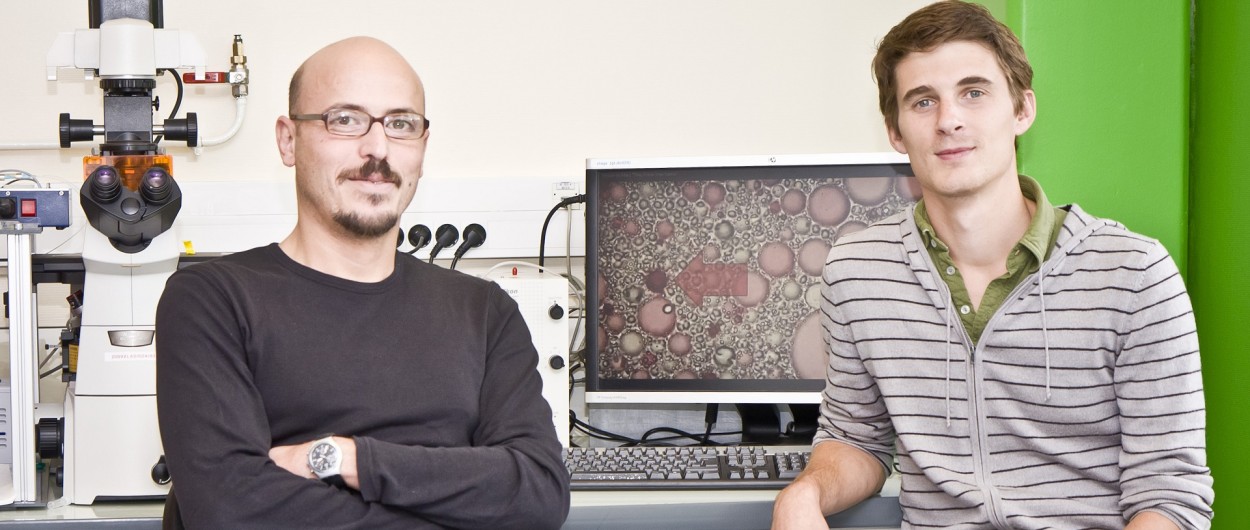Stilla technologies, a successful spin-off from the Hydrodynamics Laboratory
 Charles Baroud et Rémi Dangla, cofondateurs de Stilla Technologies
Charles Baroud et Rémi Dangla, cofondateurs de Stilla Technologies
You set up the microfluidics research activity in 2002, when you joined École Polytechnique. Is this a field where research and applications are closely linked?
Microfluidics studies fluid flows on the sub-millimeter scale. In my group, we focus on two-phase media. Air and water, or water and oil, for example. In these environments, bubbles and drops can form. How do drops and bubbles move? How does having two phases change the flow compared to having just one? These are the fundamental questions we've been asking ourselves in our fluid mechanics lab, because the primary aim is to discover new science and report on it in publications.
But microfluidics also has an important engineering side. We develop tools that can be useful in chemistry, biology, materials science and so on. In my opinion, if nobody uses these tools afterwards, we've wasted a bit of our time, even if all our research doesn't necessarily lead to applications. The purpose of companies is to make technologies robust so that they can be transferred to users who need them but are not experts in our field. I think this is another way of seeing the impact of our research, alongside publications.
How did the idea for Stilla Technologies come about?
Initially, it was a fundamental research project carried out with my thesis student Rémi Dangla (X2005 and current CEO of Stilla Technologies). We wanted to try and control drops not just in line, one behind the other in tubes, but over a wider area, using lasers. But in our experiments, the drops were ejected to the sides of the microfluidic channel, making the use of lasers impossible. As we explored the physics that determined this movement, we realized that it was due to the slight deformation of the upper and lower walls that held back the fluid. It was an unexpected result which, as is often the case in research, closed one door and opened another. We changed the subject completely, using this phenomenon not only to guide the drops, but also to shape them in the first place, using channels with complex 3D geometries. The result was really effective, which pushed us to go further.
How did you go about developing Stilla Technologies ?
Quite quickly, we filed patents on these technologies, in parallel with the classic scientific publication process. In 2011, Rémi and I decided we wanted to set up a start-up, so we took a training course in a business incubator. The idea of applying our technology to the drop-based PCR analysis system came later, after market research. We also benefited from a number of public grants, notably from the European Research Council and an ERC “proof of concept”.
This funding enabled us to expand from two people to over five. The project then really took off, and Silla Technologies left LadHyX. As a researcher and co-founder of Stilla Technologies, I was very much involved in this first phase of transferring basic science. Then, of course, there was a lot of technological and economic development, and the recruitment of hundreds of people. As a researcher, I wasn't as involved.
What lessons have you learned from this experience?
At the very beginning, I was a bit naive. It turns out that development takes time and that a lot of effort is required in addition to having a good idea. I think a number of scientific colleagues would be interested in seeing their innovation come out of their lab, but don't know how to go about it. Putting together a diverse team to set up a start-up can be a tool to support the development effort and get a technology out of the lab.
In addition to Stilla Technologies, my lab's research has also led to the creation of a second company, Okomera. Indeed, in addition to the patents that form the basis of the technology already mentioned, we have also filed patents on several applications such as DNA analysis, but also cellular analysis. Okomera is developing microfluidic chips for detailed analysis of cell cultures in three dimensions. The company is younger than Stilla Technologies - it was founded in 2020 - but it already employs around 15 people in Paris.
Finally, this combination of fundamental science and applications has attracted many students to our laboratory, who would not necessarily have chosen to pursue a PhD without this context, in addition to several post-docs and engineers. Some have used their time in the lab to join the world of startups in various roles, including as founders, on subjects different from those of the team.
*LadHyX: a joint research unit CNRS, École Polytechnique, Institut Polytechnique de Paris, 91120 Palaiseau, France
 Support l'X
Support l'X